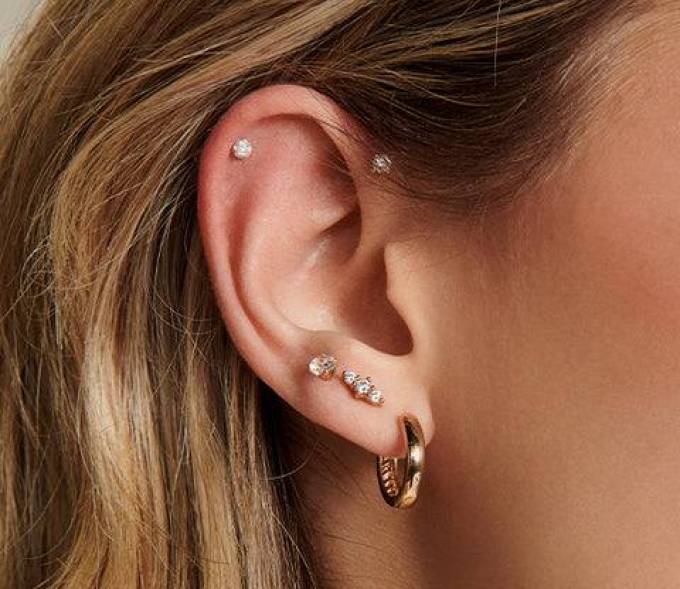All You Need to Know About Ear Piercing Costs in Dubai
Published By Dua E Zahra, 28 Oct 2024

Ear piercing is a cherished tradition and a popular fashion statement, embraced by people of all ages in Dubai. As the city continues to evolve as a hub of style and beauty, many are interested in understanding the costs associated with Ear Piercing Cost Dubai. This guide will provide you with an overview of what to expect in terms of pricing, factors influencing costs, and important considerations to keep in mind when getting your ears pierced.
Types of Ear Piercings
Before diving into costs, it’s essential to understand the different types of ear piercings available:
1. Lobe Piercing
This is the most common form of ear piercing, typically done on the soft, fleshy part of the earlobe. Lobe piercings are quick, generally painless, and suitable for individuals of all ages.
2. Cartilage Piercing
Cartilage piercings can be located in various areas, including the helix (the upper ear), tragus, and conch. These piercings usually require a more skilled technician and involve a longer healing process.
3. Multiple Piercings
Many people choose to get multiple piercings at once, combining lobe and cartilage styles to create a unique look. This can enhance your overall aesthetic but may also affect pricing.
4. Industrial Piercing
An industrial piercing involves two holes connected by a single piece of jewelry. It requires precise placement and is popular among those looking for a bolder style.
Factors Influencing Ear Piercing Costs
Several factors affect the overall cost of ear piercing in Dubai:
1. Location of the Studio
The choice of piercing studio or clinic plays a significant role in determining the price. High-end salons and medical clinics may charge more than standard jewelry stores or smaller studios. It’s essential to select a reputable location that prioritizes safety and hygiene.
2. Type of Piercing
The type of piercing you choose directly impacts the cost. For instance, lobe piercings are generally more affordable than cartilage piercings due to the increased complexity and skill required for the latter.
3. Jewelry Selection
The type of jewelry you opt for can significantly influence the overall cost. Basic studs made from surgical steel or titanium tend to be less expensive compared to more decorative options made from gold or featuring gemstones. Some studios may offer package deals that include the cost of the jewelry.
4. Experience of the Technician
The expertise of the technician performing the piercing can affect the price. Experienced professionals with specialized training may charge more, but their skill can lead to a safer and more precise piercing experience.
5. Aftercare Products
Proper aftercare is essential for the healing process and preventing infections. Many studios offer aftercare kits that may include saline solutions, antiseptics, and healing ointments for an additional fee. Investing in quality aftercare is crucial to protect your piercing.
Average Price Ranges
While prices can vary widely based on the factors mentioned, here’s a general overview of what you might expect:
Basic Lobe Piercing: Typically, this is the most affordable option, often including the cost of basic jewelry.
Cartilage Piercing: Generally more expensive due to the complexity, cartilage piercings often fall into a higher price range.
Multiple Piercings: Many studios provide discounts for multiple piercings completed during the same visit, making it a cost-effective choice.
Jewelry Upgrades: Choosing higher-quality or designer jewelry can significantly increase the total cost.
The Piercing Process
Understanding the ear piercing process can help ease any anxiety you might have:
Consultation: Before the piercing, the technician will discuss your preferences, jewelry options, and any concerns you might have. This is a great time to ask questions about the procedure and aftercare.
Preparation: The area around your ears will be cleaned and marked to ensure proper placement. For cartilage piercings, a specialized tool may be used for accuracy.
Piercing: The actual piercing can be performed using a needle or a piercing gun. Needles are generally preferred as they create cleaner holes and minimize tissue trauma
Inserting Jewelry: After the hole is made, the chosen jewelry is inserted. The technician will ensure it is securely in place before cleaning the area again.
Aftercare Instructions: After the procedure, you will receive detailed aftercare instructions. Following these guidelines is essential for successful healing.
Aftercare and Maintenance
Proper aftercare is crucial for ensuring your piercing heals well and remains free from infection. Here are some basic aftercare tips:
Keep It Clean: Clean the area around the piercing regularly with saline solution or a recommended antiseptic.
Avoid Touching: Try not to touch or twist the earrings unnecessarily, as this can irritate the piercing.
Watch for Signs of Infection: Be alert for any redness, swelling, or unusual discharge. If you notice any of these signs, consult a professional immediately.
Avoid Swimming: For the first few weeks, avoid swimming in pools, lakes, or oceans to minimize the risk of infection.
Follow Up: If you experience any complications or have concerns, reach out to your piercing professional for guidance.
Conclusion
Getting an ear piercing in Dubai is an exciting way to express your individuality and enhance your personal style. Understanding the various factors that influence costs, from the type of piercing to jewelry selection, allows you to make informed choices that fit your budget. Always prioritize safety and hygiene when selecting a location, and invest in quality aftercare to ensure a successful healing process. With a wealth of options available, you can find the perfect ear piercing that suits your style and enhances your beauty.
